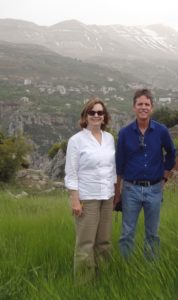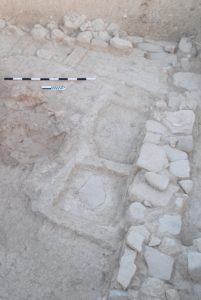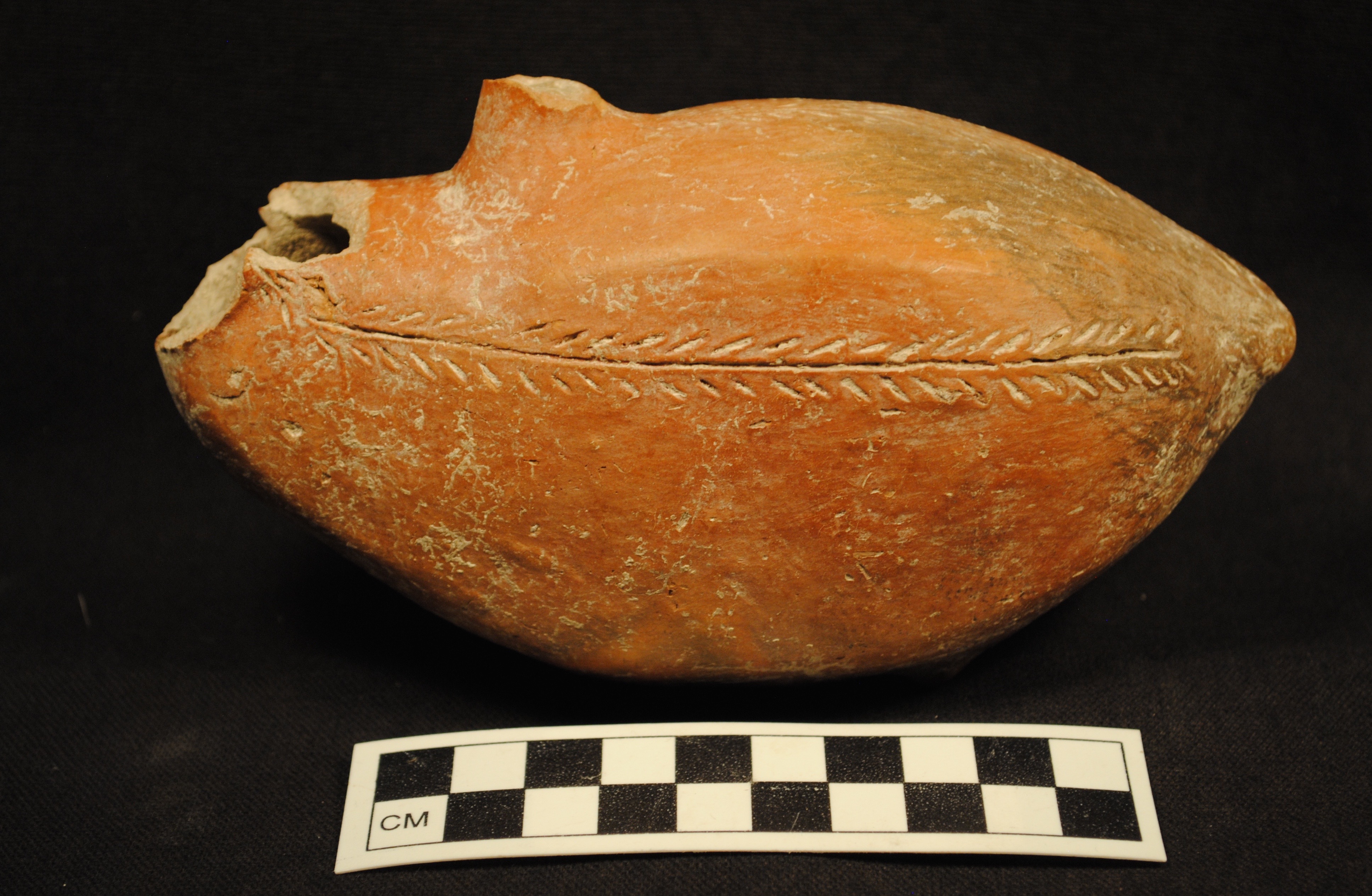The soil in the ancient Cyprus field is the color of parchment paper and packed hard. On an early summer day with temperatures that creep toward 100 degrees, UNC Charlotte researchers Steven Falconer and Pat Fall carefully dig through centuries of archaeological sediments, inch by painstaking inch. At a little more than six feet down, they examine what they have uncovered.
What they have unearthed, there in the dust of millennia, are the remains of a sizable Bronze Age celebration.
In addition to an unusual cache of deer bones, they find fragments of tools used for weaving and spinning. Nearby, nestled in the dirt, rest mysterious, human figurines crafted from red-glazed pottery. This is a collection, the researchers say, which reveals details about how ancient people lived on this island.
 The artifacts and food remains from circa 2000 B.C. are just some of the discoveries made at the buried Bronze Age village of Politiko-Troullia, Cyprus by Fall, who is a professor in the Department of Geography & Earth Sciences, and Falconer, who is chair of the Department of Anthropology. The findings not only upend some traditional views of how early civilizations developed, they also may carry implications for the sustainability of development in the world today.
The artifacts and food remains from circa 2000 B.C. are just some of the discoveries made at the buried Bronze Age village of Politiko-Troullia, Cyprus by Fall, who is a professor in the Department of Geography & Earth Sciences, and Falconer, who is chair of the Department of Anthropology. The findings not only upend some traditional views of how early civilizations developed, they also may carry implications for the sustainability of development in the world today.
“The people of Politiko-Troullia lived during the centuries just before the first cities on Cyprus,” Fall says. “That’s one reason we work in Cyprus. The Bronze Age is really when civilization started and cities developed.”
Cyprus lies in the eastern Mediterranean, just south of Turkey. Since 2007, Fall, Falconer and teams of colleagues and students have been visiting to excavate the ground beneath farm fields to investigate what life in its Bronze Age villages was like. They directed a summer 2015 Education Abroad program with UNC Charlotte students excavating on Cyprus and conducting a geographic survey of the countryside.
Fall and Falconer came to UNC Charlotte in January 2015, bringing extensive research resumes to the university and to the exploration of early civilization, including their work previously in Jordan and currently in Cyprus.
Fall’s expertise is in paleoecology, while Falconer is an archaeologist. Fall researches sediments, ancient pollen, plant macrofossils and charcoal. Seeds and plant remains can persist for thousands of years if they are burned, and they provide vital clues to ancient plants, trees, human diet, fuel usage and even climate.
As part of Falconer’s archaeological field research, soil resistivity survey, in which a portable apparatus measures electrical resistance below the modern ground surface, can reveal buried ancient stone walls. This process helped to create a subsurface map of Politiko-Troullia’s houses, courtyards and alleywas. Excavations directed by Fall and Falconer have revealed broken pottery, animal bones, seeds, charcoal, chipped stone tools and metallurgical refuse, all of which reveal ancient lives lived before the development of writing..
The researchers’  work overlaps, as both are interested in the development of early cities and social landscapes, how people settled on the landscape and how social relationships and society changed through time. They have received funding from the National Science Foundation, the National Geographic Society, the National Endowment for the Humanities and the Wenner-Gren Foundation for Anthropological Research.
work overlaps, as both are interested in the development of early cities and social landscapes, how people settled on the landscape and how social relationships and society changed through time. They have received funding from the National Science Foundation, the National Geographic Society, the National Endowment for the Humanities and the Wenner-Gren Foundation for Anthropological Research.
Their previous excavations in Jordan revealed a landscape that, by the middle Bronze Age, had been completely transformed by human habitation and agriculture. Native forests had been felled as cities expanded. This pattern is evident throughout the ancient eastern Mediterranean mainland.
“In the Neolithic period, we still see wild resources being used,” Fall says. “But very quickly the population grows so rapidly that humans and agriculture became completely interdependent. By the time we get to the Bronze Age, the Middle East had a completely managed landscape. Modern Iraq, Syria, Lebanon, Israel, Jordan — people were almost exclusively dependent on agricultural products. Our excavations in Jordan produced relatively few bones from fish, birds or wild game, suggesting very little exploitation of wild resources.”
On Cyprus, something different happened.
When people colonized the island at the beginning of the Neolithic Period, they brought with them plants and animals, including wild game. Unlike their mainland contemporaries, these settlers did not clear all of the oak and pine forests for agriculture. Fall’s analysis of charcoal and burned seeds from Politiko-Troullia shows that woodlands grew in the mountains and foothills of Cyprus, while Bronze Age farmers also used terraced hillsides to grow crops. In contrast to Middle Eastern evidence of deforestation, dense populations and large cities, these researchers find lingering signs of habitation in dispersed villages across a landscape with persistent wild plant and animal resources.
“Their way of life was fundamentally different from that of mainland populations,” Falconer says.
 When the first Cypriot settlers arrived on boats, along with their domestic livestock, they brought unusual passengers – wild deer.
When the first Cypriot settlers arrived on boats, along with their domestic livestock, they brought unusual passengers – wild deer.
“They brought Mesopotamian fallow deer with them,” Fall says. “Then they released them and hunted them.”
The celebration whose remnants Fall and Falconer uncovered in their excavations at Politiko-Troullia suggests that the imported deer were not part of a Bronze Age return to hunter-gatherer roots. Rather, these animals were hunted for ritual reasons, as well as for regular table fare.
The deer bones have shown up in large numbers in outdoor, communal spaces, along with other objects – spindle whorls, loom weights, stylized human figurines – that Fall and Falconer suspect may have been related to communal celebration of personal events, or the turn of a calendar.
“They were feasting on these deer,” Falconer says. “And probably carrying on other kinds of social interactions and economic transactions.”
One of their papers, “Bronze age fuel use and its implications for agrarian landscapes in the eastern Mediterranean,” published in December 2015 in the Journal of Archaeological Science with JoAnna Klinge of Arizona State University, compared the carbonized seeds and charcoal excavated from four Bronze Age settlements in the eastern Mediterranean to determine how people obtained and used fuel.
In overview, the people of Bronze Age Cyprus appear to have lived more lightly on the land than contemporaneous mainland populations, more in keeping with the island’s carrying capacity. These insights from ancient Cyprus hold implications for people today.
“The landscapes of the Mediterranean basin are quintessentially anthropogenic, or human-made, because they have been cultivated and grazed for millennia, arguably for 10,000 years or more,” Falconer says. “It’s interesting and important to understand how we got there, also with an eye to what the human role is going to be in the future.”
One story the settlement of Cyprus can tell us, the researchers say, is that the future is not a foregone conclusion. “We talk about first cities, first writing, first government, but there are different routes to these innovations,” Falconer says. “Cyprus is different from other places; it’s not about population growth and pressure.”
Often, both laypeople and scientists see how society or landscapes developed to their modern configuration and think this was the inevitable outcome, Falconer says. “Cyprus points out that there are different possible configurations,” he says. “Human history and prehistory could have taken different avenues.”
Words: Amber Veverka | Images: Pat Fall, Steven Falconer and Sidney Rempel








